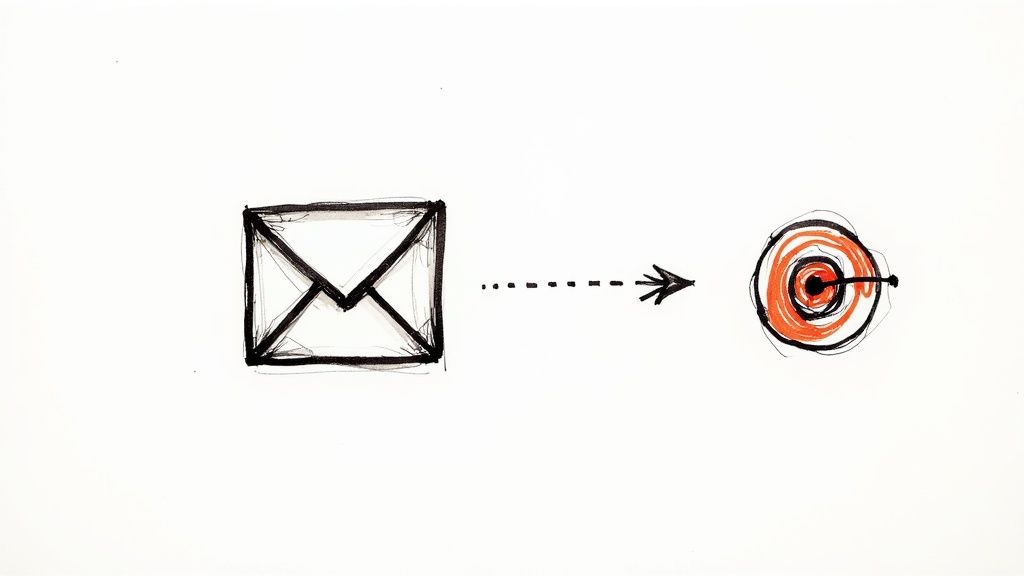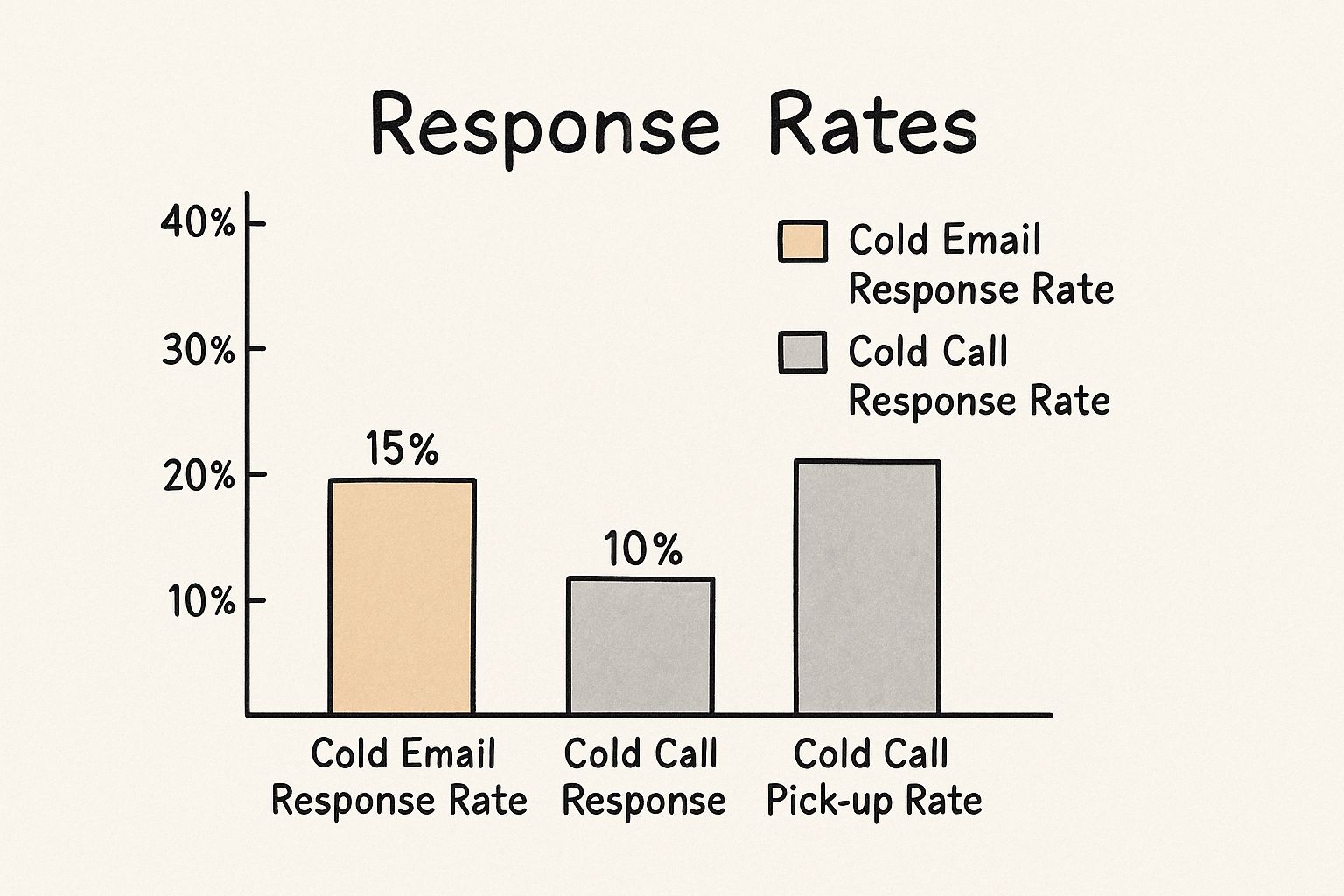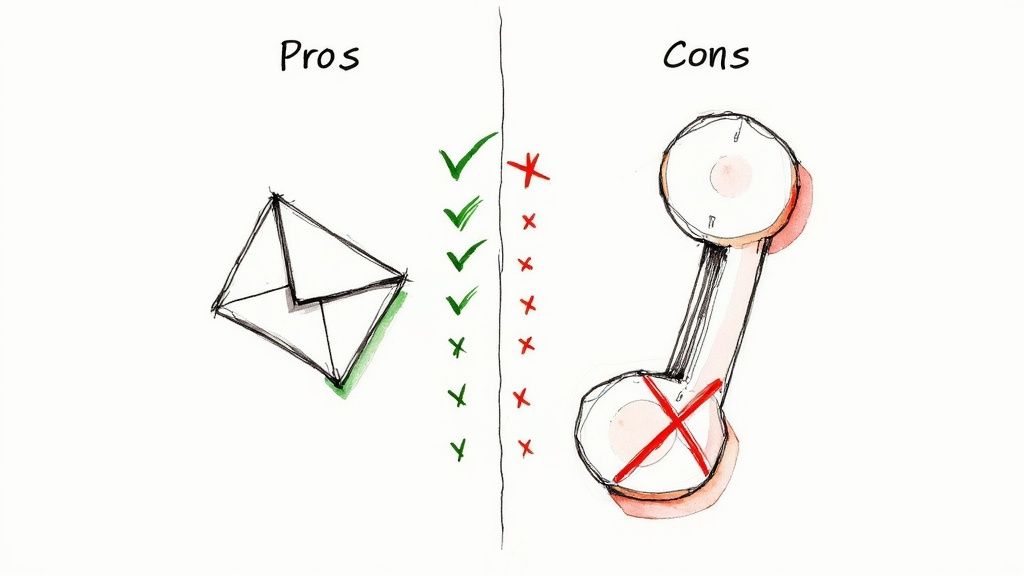The age-old debate in sales circles: cold email vs cold call. Truth be told, there's no single winner. The real secret is knowing which tool to pull out of your toolbox for a specific job.
Cold email lets you reach out in a scalable, less intrusive way. It’s perfect for getting a foot in the door. On the other hand, a cold call gives you that immediate, personal channel for a real conversation. Which one you lean on will ultimately come down to your industry, who you're trying to reach, and what you want to achieve with your campaign.
Choosing Your Outreach Method

The classic cold email vs. cold call showdown often misses the most important point: modern sales pros use both. Instead of pitting them against each other, think of them as complementary parts of a single, powerful outreach strategy. Each one shines in different scenarios.
Cold emailing is fantastic for contacting busy professionals who guard their time fiercely. It drops your value proposition right into their inbox, letting them check it out when it works for them. This approach is incredibly scalable, too—with the right automation, you can reach out to thousands of prospects without breaking a sweat.
But then you have cold calling. A phone call creates an instant, human connection that email just can't match. It’s the go-to for complex, high-ticket sales or for industries where a real conversation is still king.
The real question isn't which one is better, but when to use each one. A successful strategy knows how to sequence a non-disruptive email with a well-timed, contextual call to maximize engagement.
To help you figure out where to start, let's break down the core differences between the two methods.
At a Glance Comparison Cold Email vs Cold Call
Here's a quick look at how cold emailing and cold calling stack up against each other on some key attributes.
This table gives you a high-level view, but the best choice always comes down to your specific situation—your audience, your offer, and your team's strengths.
Analyzing Performance And Scalability
When it comes to the cold email vs. cold call debate, performance and scalability are where you see the biggest differences. Cold emailing is built for volume and efficiency. It’s a numbers game, really. A single sales rep can hit up hundreds, even thousands, of prospects in the time it would take them to dial a handful of numbers. That’s its core strength.
Cold calling, on the other hand, is a high-effort, low-volume game. Sure, one great call can be a game-changer, but the work it takes to get there is immense. You're constantly fighting through gatekeepers, getting sent to voicemail, and hoping to catch a decision-maker at just the right second. That’s a tough process to scale.
Measuring Success Across Channels
The data tells a pretty clear story about efficiency. For targeted campaigns, cold emails typically see a response rate between 15% and 25%, with 1% to 5% of those leads eventually becoming customers. Cold calls? They have an average activation rate of just 2.3%. That means very few calls actually lead to a real next step, like a scheduled meeting.
This really highlights email’s power for generating that initial spark of interest at scale. Of course, converting those leads is another story—that’s where solid processes come in. Following effective sales pipeline management tips is crucial for making the most of the leads you generate, no matter which channel you use.
The real difference isn’t just about response rates. It's about the sheer effort you put in for every single successful interaction. A sales rep might have to make eight call attempts just to have one conversation.
The infographic below breaks down how key engagement metrics stack up for each method.

As you can see, while call pick-up rates might look decent on the surface, the actual response or engagement rate for email often pulls ahead. To hit those high email response rates consistently, you need a solid strategy. Our guide on cold email best practices walks you through everything from personalization to follow-up sequences.
At the end of the day, if your goal is to cast a wide net and generate a broad base of initial interest, email’s performance and scalability are tough to beat.
Comparing Your Return on Investment and Costs

When you get down to brass tacks, the financial bottom line often settles the cold email vs. cold call debate. Every sales activity costs something, but the real question is which one gives you a better bang for your buck. To get the full story, you have to look past the software subscription fees and factor in your biggest expense: your sales reps' time and salary.
Let's run some numbers. A hypothetical cold email campaign might run you about $4,500 per month, once you account for a rep's salary and software. Sending 1,000 well-crafted emails could pull in roughly $92,400 in revenue. That breaks down to an impressive ROI of $20.50 for every single dollar you spend.
Now, let's look at cold calling. A campaign targeting 1,200 prospects could have a slightly higher monthly cost of around $5,000. This effort might generate about $76,800 in revenue, which gives you an ROI of $15.36 per dollar. It's still a profitable channel, no doubt, but the return just isn't as high as what email can deliver.
Key Financial Differences
The main cost driver in cold calling is people. It's a time-consuming, one-on-one grind that demands a lot of manpower to scale effectively. Every dial, every conversation, and every follow-up eats up precious minutes of a sales rep's day, making it a pricey way to do broad outreach.
Email, on the other hand, wins on scalability. A single salesperson, armed with the right tools, can reach out to thousands of prospects at once. Platforms that provide cold email automation slash the manual labor involved, freeing up your team to nurture warm leads instead of just banging on cold doors.
This scalability is exactly why cold email often comes out on top as the more cost-effective engine for lead generation. It's especially true for businesses trying to stretch their budget and cast a wider net.
Of course, these are just models. To really know what's working for your own outreach, you need solid strategies for accurate ROI calculation. But when you look at the data, it consistently points to one thing: cold email generally provides a much bigger financial return for the resources you put in.
When to Use Each Outreach Method
The whole cold email vs. cold call debate isn't about crowning a permanent champion. It's really about knowing which play to call and when. The smartest outreach strategies mix and match, deploying the right tactic for the right situation to make sure your message actually lands.
Ultimately, your choice should boil down to who you're trying to reach, what industry they're in, and how complex your offer is.
When Cold Email Is Your Best Bet
Cold email really shines when you need to be efficient and non-intrusive. It's the perfect channel for getting in front of busy executives or tech-savvy folks who live in their inbox and prefer to manage their own time. If your goal is just to share something valuable, like a case study or a webinar invite to warm up leads, email is the ideal low-pressure way to do it.
Think about using email in these situations:
- Targeting Busy Decision-Makers: You can get your value proposition across without blowing up their schedule with an unexpected call.
- Warming Up a Large List: Email lets you nurture thousands of prospects at once with great content before you ever ask for a meeting.
- Selling Lower-Priced or Simple Products: When the value is straightforward and easy to get, a sharp, concise email is often all it takes to get someone interested.
When to Pick Up the Phone
On the flip side, a cold call becomes your go-to move when what you really need is an immediate, human connection. If you're targeting more traditional industries like manufacturing or construction, where a lot of business still gets done over the phone, calling feels much more natural.
A phone call is indispensable when selling complex, high-ticket solutions that require a consultative conversation to uncover pain points and explain nuanced value propositions.
While the average cold call conversion rate is around 2.35%, don't let that number fool you. It can swing wildly depending on your team's skill and the industry you're in. Consistent training and smart targeting are what separate the top performers from the rest, as shown in this detailed analysis of cold call conversion rates. To give your team an edge, check out these actionable cold calling tips that can help make every conversation count.
Building a Winning Hybrid Outreach Strategy

The best sales teams I've worked with have stopped arguing about cold email vs. cold calls. It’s a settled debate. The real wins come from blending the scale of email with the personal connection of a phone call.
A hybrid strategy isn't just about switching between channels for the sake of it. It’s about making them work together to create a single, seamless outreach sequence that feels natural to the prospect.
Think about it from their perspective. A call out of the blue is an interruption. But a call that follows up on a thoughtful, non-intrusive email? That’s a relevant conversation. This simple shift provides context and makes your call feel less… well, cold. In fact, more than half of high-level buyers actually prefer getting a call after you’ve already made some initial contact.
A Practical Hybrid Framework
So, how do you put this into practice? A smart hybrid model uses your email engagement data to decide who you should call. It's that simple. By tracking who opens your emails or clicks your links, you can prioritize calling prospects who've already raised their hand, even just a little.
This data-first approach means your reps aren’t just dialing into the void. They’re focusing their valuable time on the warmest leads who have already shown a flicker of interest.
Let's walk through a simple 10-day hybrid cadence to see how this looks in the real world.
This multi-channel flow turns your outreach from a series of disconnected jabs into a cohesive, strategic conversation. You respect the prospect's time while creating multiple touchpoints, which dramatically increases your chances of getting that meeting booked.
To really nail this, you need to have your fundamentals down, which we cover in our guide to cold email outreach. Of course, managing a hybrid workflow like this manually can get messy fast. That's why it's worth checking out some of the best sales apps for boosting revenue to keep your efforts organized and effective.
Common Questions About Sales Outreach
After breaking down cold emails and cold calls, you're probably wrestling with some real-world questions. It's one thing to compare them on paper, but another to know how they actually work in the trenches. Let's tackle some of the most common questions sales pros have.
Is Cold Calling Still Effective Today?
Yes, but it's not the same beast it was a decade ago. Think of it less as a first touch and more as a strategic weapon. Cold calling shines when you're dealing with high-value deals, selling complex products, or trying to reach executives in traditional industries who still live on their phones.
The smartest teams don't just call out of the blue. They bake it into a multi-channel approach. A call that references a recent email you sent or a LinkedIn comment isn't really "cold" anymore—it's lukewarm, and that context makes a world of difference in getting someone to listen.
What Is a Good Response Rate for Cold Email?
For a solid, well-run cold email campaign, you should be aiming for a response rate somewhere between 15% and 25%. But that number is hugely dependent on your list quality, how much you've personalized your message, and the industry you're in.
If your reply rate is sinking below 10%, that's a red flag. Something's off—it could be your targeting, your subject line, or the body of your email. The golden rule is to prioritize a smaller, hyper-targeted list over a massive, unvetted one. Quality always trumps quantity here.
Key Insight: Don't get distracted by vanity metrics. A 15% reply rate from 100 perfect-fit prospects is infinitely more valuable than a 5% rate from a list of 1,000 random contacts.
Should I Use a Script for My Cold Calls?
You should use a framework, never a word-for-word script. Reading from a script is the fastest way to sound like a robot and kill any chance of a genuine conversation. The whole point of a call is the human connection; a rigid script destroys that.
Instead, build a flexible framework. This should include your key talking points: how you'll introduce yourself, your one-sentence value prop, a few critical qualifying questions, and pre-planned answers to the objections you hear all the time. This keeps you on track without sounding rehearsed.
How Do I Personalize Cold Emails at Scale?
Scaling personalization is all about a smart mix of segmentation and automation. First, slice up your prospect list into logical groups based on things they have in common, like their industry, company size, or even a recent funding announcement. Then, use basic merge tags like {{FirstName}} and {{CompanyName}} to cover the fundamentals.
The real magic, though, comes from "custom snippets." These are short, hand-written sentences you add for each prospect, referencing something specific you found—a recent award, a quote from a podcast, or a post they wrote on LinkedIn. To really master this, you need a solid cold outreach strategy that pulls all these pieces together.
Ready to scale your outreach with precision and intelligence? PlusVibe uses AI to help you send hyper-personalized cold emails that land in the primary inbox and get replies. Start your free trial today and see why over 1,500 marketers trust us to power their campaigns.














































.jpeg)


.png)

















































